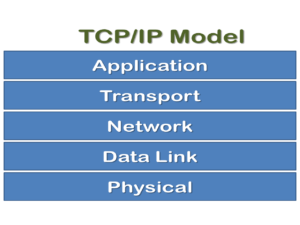tcp ip
The Internet is basically a collection of networks and gateways that use the TCP/IP suite of protocols to communicate. TCP/IP is an acronym for Transport Control Protocol/Internet Protocol and is a method of communicating packets of data between computers. It was originally created by DARPA, an agency of the United States Department of Defense in 1958. TCP/IP uses packet-switching technology, which means data can be routed to a destination through any number of transmission points, making the network decentralized and less vulnerable to equipment failure. TCP provides data integrity and delivery guarantee, by transmitting, and retransmitting packets until the receiver acknowledges the reception of the packet. IP is used to send packets of information to a host based on an IP address. A datagram is more basic than a packet, and is in fact the basic transfer unit associated with a packet-switched network.

TCP IP
Delivery, arrival time, and order of arrival need not be guaranteed by the network, such guarantees are provided by additional layers, to for example provide datagram checksums. The details of TCP/IP in the table below have been simplified into 4 layers. When a computer communicates with another computer, normally all the layers shown below are used, except that only certain protocols may be applied:

Application Layer ( TCP IP )
This makes the communication between programs and the transport layer
HTTP (Hypertext Transfer Protocol)
FTP (File Transfer Protocol)
DNS (Domain Name Service)
DHCP (Dynamic Host Configuration Protocol)
Transport Layer ( TCP IP )
Used to establish basic host to host communications through routers. UDP provides data integrity via checksums. TCP provides both data integrity and delivery guarantee by retransmitting until the receiver acknowledges the reception of the packet. TCP (Transmission Control Protocol) UDP (User Datagram Protocol)
Internet Layer
Has the function of sending packets of data across networks. IP is used to send packets of information to a host based on an IP address.
IP (Internet Protocol)
ICMP (Internet Control Message Protocol)
ARP (Address Resolution Protocol)
Network Access Layer
Network hardware protocols such as Ethernet
Note: The above table is not intended to be an exhaustive list of protocols, but rather to just provide an indication as to what each layer is and how it may function. A good way to explain the layers and the suite of protocol listed, is to draw an analogy to the ‘snail mail’ postal system:
It starts at home in the Application Layer, where you decide that you want to send a letter to someone… The Transport Layer is a bit like what type of letter you send: UDP is like regular mail, to send a letter out you just pop it in an envelope and send it off. If it’s something the recipient requested and they don’t receive it they will request it again. If it’s something you wanted and didn’t get a reply, you will just request it again. TCP is a bit like regular mail, but also requires a receipt signature, and the sender receives conformation of successful delivery of the package.
Larger more important pieces of data tend to be sent via TCP, but this transfer protocol does have a slightly larger data overhead. The Internet Layer is a bit like how you address a letter. The sole purpose of IP is to address the packet. It does this by adding additional data to the datagram. ARP is used to resolve a MAC address (the physical address of a computer) within a network and ICMP is a diagnostics protocol for IP.
The data packets are then communicated via the Network Access Layer, which is a bit like the postal delivery infrastructure; with trucks, planes, roads, sorting offices and the people who actually deliver the letters to your door. The point of this section has not been to provide a detailed description of TCP/IP, but to ensure that you have a reasonable notion about what TCP/IP is, and at least roughly how it functions as a suite of communication protocols. This will help you better understand some of the tools and methods mentioned in this book.
I hope that you understand my post. if you like this post then share my post, and comment on my post if you have any suggestion or Queries related to TCP/IP. Thank you!




